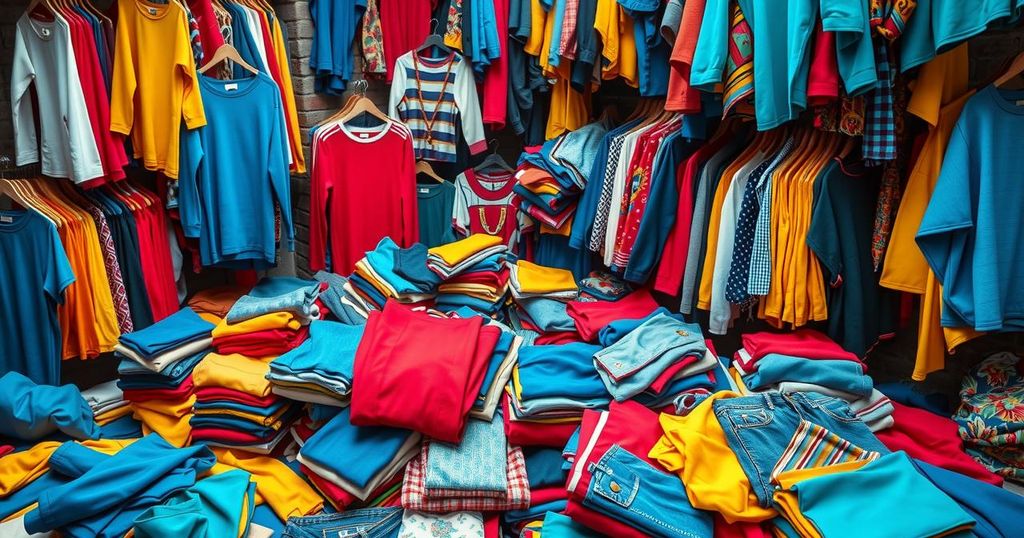Kenya’s mitumba market has surged significantly, becoming the largest importer of second-hand clothing in Africa with imports hitting $298 million in 2023, up 12.45% from 2022. This growth is driven by demand for affordable apparel, contrasting with restrictions seen in neighboring countries. Recent tax cuts have further boosted imports, diverging from local textile industry interests. Understanding this complex balance is crucial for future policymaking.
Recent data from the Massachusetts Institute of Technology (MIT) indicates that Kenya’s mitumba market, which comprises second-hand clothing, has grown significantly, with imports reaching $298 million (Sh38.5 billion) in 2023. This figure surpasses that of Nigeria, which has a much larger population, affirming Kenya’s position as Africa’s largest importer of used apparel, amid challenges facing local textile production.
The rise in mitumba imports reflects a 12.45% increase from the $265 million (Sh34.28 billion) observed in 2022. This demand is primarily driven by the need for affordable clothing options. Traders are importing a diverse array of second-hand items, including undergarments, trousers, dresses, jackets, shoes, and household textiles such as curtains and bedding.
While Kenya’s market flourishes, neighboring countries like Uganda, Rwanda, and Ethiopia are adopting stricter regulations to bolster their local textile industries. In contrast, Kenya’s lax policies have allowed a continuous influx of used clothing, which contrasts with the current import duties of 35 percent or $0.20 per kilogram applied on goods from outside the East African Community (EAC).
Additionally, the Tax Laws (Amendment) Act, 2024 has eliminated two essential taxes—the Import Declaration Fees (IDF) and the Railway Development Levy (RDL)—further minimizing import costs. This legislative change has faced criticism from local manufacturers and officials, who argue that it undermines efforts to rejuvenate domestic textile production and supports a market dominated by imported second-hand clothing.
Amid Kenya’s burgeoning mitumba trade, some government officials have expressed concerns that the country functions as a transit hub for smuggled second-hand clothes destined for other markets. This complicates regulatory efforts. Furthermore, Kenya’s participation in the African Growth and Opportunity Act (AGOA) remains precarious, as it necessitates maintaining open borders for second-hand clothing imports, following the experiences of countries such as Ethiopia and Uganda, which withdrew from AGOA after instituting bans on similar imports.
The ongoing debate surrounding the mitumba trade remains polarized among Kenyan policymakers. Proponents assert that it provides essential clothing options for low-income households, while critics argue it hampers the local textile industry’s potential. Despite various government attempts to revitalize this sector, including recent initiatives aimed at modernizing textile manufacturing and supporting cotton farmers, progress has been minimal against the backdrop of a thriving second-hand clothing market.
In an effort to support local textile production, the government is working on enhancing the Rivatex East Africa factory in Eldoret, aiming to attract strategic investors to increase its output. The earlier proposed National Cotton, Textile, and Apparel (CTA) Policy 2024 seeks to strengthen the industry by establishing textile value-addition centers and upgrading cotton production facilities.
Furthermore, the government intends to equip county development centers with tailoring facilities and launch international marketing campaigns to promote Kenyan textiles. Collaborative efforts are in place to identify and address unfair trade practices that affect the sector, as Kenya seeks to balance the booming mitumba market with the revitalization of its local textile industry.
In conclusion, Kenya’s mitumba market is witnessing significant growth, driven by rising demand for affordable clothing and supportive policy shifts. Despite criticisms from local manufacturers and regional economic pressures, Kenya continues to set records in second-hand clothing imports, highlighting the complexities of balancing this market with revitalization efforts in the local textile sector. The government’s initiatives to promote sustainable textile manufacturing may ultimately determine the future dynamics between these competing interests.
Original Source: eastleighvoice.co.ke






